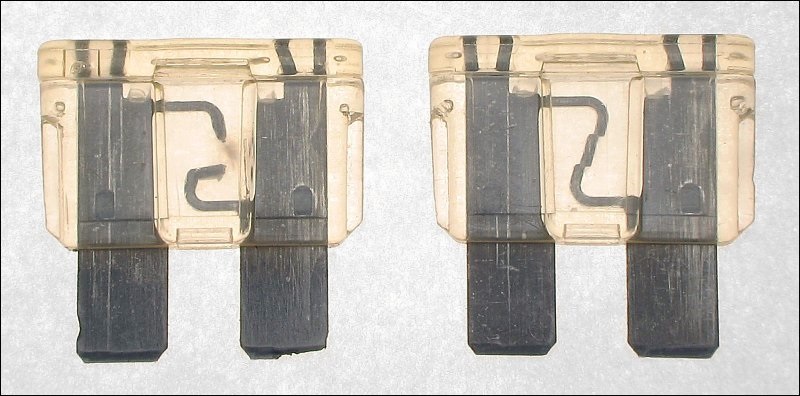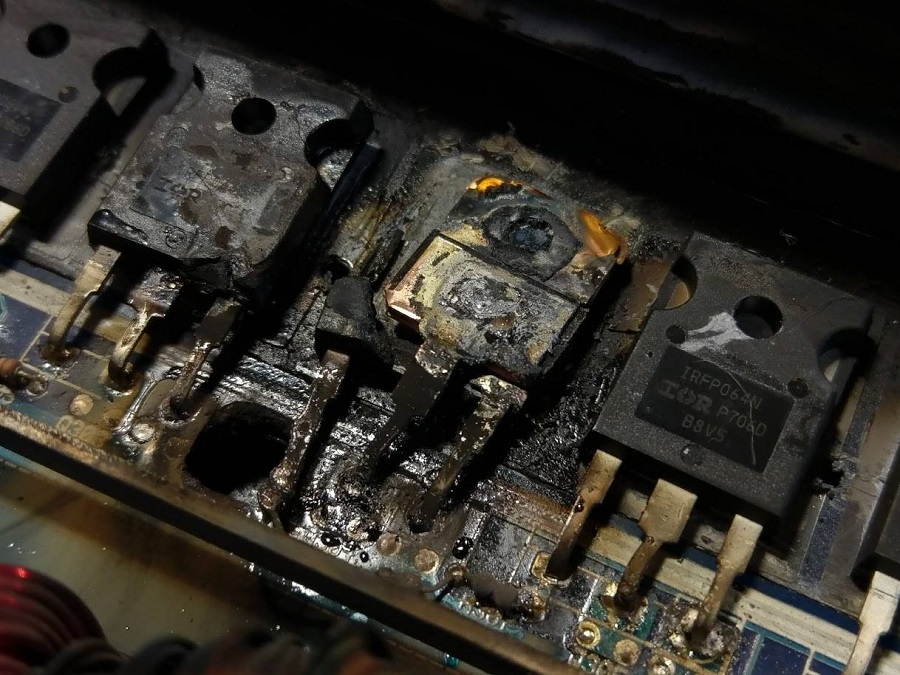“Why is my car amplifier not working?” Well, hopefully we’ll be able to answer that question for you in this article.
Let me start with a little tale of caution. I loved the old Japanese Sansui car stuff. Their small car amplifier called the SM-100 actually made a true 32W RMS. I had three, running each bridged. I had one for each mighty cast-chassis JBL T595 ‘Decade’ 6×9 speaker. The third was for my 12in re-coned free air subwoofer, taken from the trash at work. I still used the head unit’s onboard power, though! Rears went to a second pair of 6x9s in the parcel shelf and the front channels ran the doors. The three SM-100s were board-mounted. I used pro audio connectors to supply power and audio signal feeds. A mighty 1/0Ga main power wire supplied a brass bus-bar on the board. It was well-cabled as I was trained in wiring for studios and P.A. systems. For the final fuse before each amp, I still used the stock wire and fuse holder the amps came with.
This was a problem as I was driving them very hard, bridged, continually. I kept on blowing fuses until I found the 35A sliced ceramic cylinder type. This held two ceramic halves with rings of metal with a fusible link between, as one piece. The rings fitted the power cable grippers, and a plastic fuse holder snapped around it.
I would lose an amp going around a corner too hard. I found that the fuses had been running as molten liquid metal in the middle! Still conducting but melted. When the metal flowed sideways, the power was cut, leaving a solid ‘drip’ of fuse remains!
The fuse holders became burnt and crusty. How I didn’t have an auto-fire I do not know. Modern 12V power parts are much better and safer.
So why might *your* amp not be working? Let’s take you through some systems analysis…
‘Known Good’
When we ask about an amp not working, it will be about it being in a system. That said, it is always a good idea to have each amplifier tested briefly before its first installation. Just seeing that it powers up is what you want. Full ‘soak-testing’ will cost time and effort. But starting with a system with components that were known to be ‘good’ in the first place is sensible. A brief connection to some 12V, to check it powers up, is needed. For speakers, a little 1.5V battery in a holder or with a wire soldered to each end is great tester. Tickle the terminals with the battery, just gently. The speaker will move visibly or a tweeter will make crackle tones.
But your amp’s not working. WHY?
Protection Racket!
Because car electronics systems are such saggy-pants things in electrical terms, all DC-based (battery powered) stuff needs ‘protection’. Most run-of-the-mill amplifiers for cars come with an LED indicator or two. Usually a green one to indicate that the power is on, and often another, red one. That that lights up if a protection circuit has kicked in. Sometimes the LED can change color from green to red and let you know that it has entered ‘protect’ mode.
These modes are usually Over Voltage, Under Voltage, Thermal and Short-Circut. If any of these things happen, your amplifier will shut down rather than brew up. That means going ‘splutt’ inside and letting the majicke smoke out… or it means an electrical fault. The Voltage thing is unlikely to be about over-volts, but too low a voltage DC supply can kill amplifiers. Some of the most expensive amps in the world use a special power supply to guard against this. The BRAX MX4 can deal with five seconds at a low 6V DC when a car is re-started in traffic. The truly hench Orion HCCA subs and amps were famously not terribly efficient. But, like the awful drag coefficient of a Countach all those years ago, they still performed, with huge powerful sound. They both just ‘pushed a lot of air out of the way to do it’. Trouble was, HCCAs didn’t cope well with sagging power supplies. They tended to get horribly ill inside and die, through under-voltage. Americans expected big engines with multiple alternators to run them. Under-voltage is bad, m’kay?
Which Circuit Have You Triggered?
Check your system voltage when it is running. Hint; if your headlights dim/flicker on bass notes and you have a stock alternator, you’ve overloaded your stock electrics. That low voltage may be why your amp has stopped, to save its own insides from harm.
As for thermal protection, has your amplifier suddenly stopped after you have been playing music really loud? And for a long time? Was it the bass that cut out first? OK, pull over and feel your amp. It is HOT? If yes, then you have cooked it, and once cooled, this will start back up. Try fitting a 12V cooling fan. The kind used in a computer tower, to push air around the heatsinks to keep the amp cooler in future.
The last nasty is a sudden stop because of a short circuit. This is most likely to be about a speaker cooking where you have driven the amp too hard. Clipping or over-driving an amplifier makes square waves, not curvy ones. The square bits are where the speaker coil will be just barbecuing for no result. When a coil fails on the back of a speaker, they often short-out near their entry point. That looks like a short circuit to the amplifier, thus it will enter protect mode and shut down. Daft but true, you can sniff each speaker to see if you can smell burning. Or you can disconnect each speaker wire one at a time from the amp, to see if protect mode stops. If you disconnect a bad one, the amp will be happy. Check the amp’s speaker terminals for metal debris shorts, too.
Your taste might need more amplifier power. Or else you need to have your gain structure (system signal levels) reset by an expert, to make it foolproof.
Can you HEAR ME?
The amp is on and all the little lights light up but the sound has gone crackly in one channel and then stopped! What in heck? I was not being a hooligan with the volume, knob, either… this time! You could have lost signal with a dodgy RCA cord. Car audio technology should always have used a latching true-balanced micro XLR connector because of the hostile environment for sound. All that vibration and electrical interference. This never happened, though, and we use the essentially domestic RCA plug format. Some top-end car amps do use XLRs. The RCA plug is literally as old as the company that made 78RPM records. It is also called Phono plug – for record players. An old plug format, cheap ones can literally fall out of a plug socket. This is why there are legendary brands of heavy-duty chassis-mount RCA sockets that amp makers brag about using. Yes, saying you have WBT connectors marks you out as a posh brand. Knowing that, makes you an expert.
Alternatively, vibration from simply driving around can cause micro-flexure of the metal conductors within an RCA cord, especially those cheapies. Over time, they can get metal fatigue and snap. Or add crackles and pops as the signal breaks, fizzes and reconnects a bit. In a big system there will be a lot of plugs and the best stuff is mostly custom made. Truth is, ‘dry joints’ or soldering with shrink-fractures that cooled too fast, can happen even for good wire makers. This can result in conductors simply snapping loose inside a plug, later. If you do find an RCA cord with a fault, the likeliest fault will a bad joint inside the plug.

FUSE Gone Phutt?
What if the music stops and won’t go back on, just won’t power back up? Your system, or part of it has just stopped? You pull over and inspect the system fuses. The amp, the fusebox near the amp and the main big fuse in the power line to the amps. If any have blown, don’t just fit a bigger fuse and forget it, unless you really are running above that amperage draw. As long as the cable length and diameter permit, and your fuse holder standard reaches up that high, (ANL, MAXI, etc) then, you can increase the amperage. But you should have got that right when you designed the system.
If you have got dead fuses, this tells you where your problem is. The closer the fuse is to the main supply, the bigger your problem. If it is the main fuse, and it blows as soon as you put it back, system off, you have a dead power-to-earth short. Big, ugly and unlikely. If a fuse in the distribution block is popping, then you probably have an unwell amp. If the one on the amp is dead, you may have blown your output MOSFET transistors; pricey!

You Really DID It This Time!
You are running a big system, installed by talented artisans and yep, suddenly, one part has gone quiet. Half your woofers are no longer woofing. What is the matter? Well, here, finally we reach the need for an amplifier fixer. Repairers are uncommon in car audio as everything is so compact and fiddly. It can get expensive repairing a big automotive amplifier. Once you get a nasty fault condition and the operator doesn’t notice, your power output FETs can detonate like popcorn. All of them, pop, pop, pop… and that can get costly. The pictures of “Oooh nasty!” in the world of big car audio amplifier repairs are all filled with charring. You can practically smell the images.




